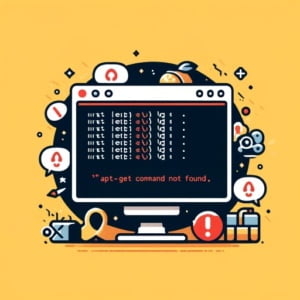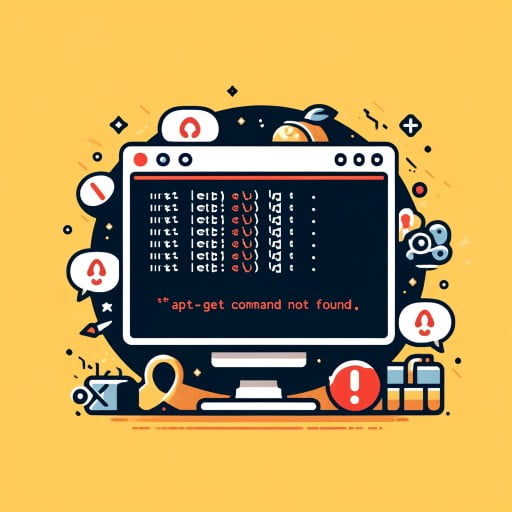21 Might 2024
Solving ‘apt-get command not found’ | Linux Consumer’s Information

Day managing servers at TECHTALKNEW., we regularly troubleshoot the 'apt-get command now not discovered' message. This factor may also be specifically perplexing for customers aware of Linux environments the place ‘apt-get’ is a regular bundle supervisor command. In nowadays’s article, we delve into sensible steps to get to the bottom of the ‘apt-get command not found’ error, offering adapted answers and choices for each our devoted server internet hosting shoppers and fellow builders.
On this information, we’ll aid why the ‘apt-get command not found’ error occurs and easy methods to get to the bottom of it. We’ll discover the apt-get command, its position in Linux techniques, and delve into alternative bundle managers that may be worn if apt-get isn’t to be had. We’ll additionally speak about regular problems alike to the ‘apt-get command not found’ error and their answers.
So, let’s dive in and get started resolving the 'apt-get command now not discovered' error!
TL;DR: How Do I Unravel ‘apt-get command not found’?
The
'apt-get command now not discovered'error most often happens in the event you’re the use of a Linux distribution that doesn’t come with apt-get, or if the gadget PATH is incorrectly eager. To resolve you’ll be able to, importance some other bundle supervisor like dnf,sudo dnf set up apt, or right kind the gadget PATH if the APT bin listing (most often ‘/usr/bin’) isn’t integrated within the PATH,export PATH=$PATH:/usr/bin.
Right here’s a easy instance of the way you may come across this mistake and a unadorned resolution:
apt-get replace
# Output:
# 'apt-get command now not discovered'
On this instance, we attempted to replace our bundle lists the use of the apt-get replace command. Then again, we encountered the ‘apt-get command not found’ error as a result of our Linux distribution doesn’t come with apt-get or our gadget PATH is incorrectly eager.
To get to the bottom of this, shall we set up some other bundle supervisor like yum or pacman, or right kind the gadget PATH. For example, if we have been to importance the yum bundle supervisor, the similar command can be yum replace.
This can be a unadorned strategy to the ‘apt-get command not found’ error, however there’s a lot more to be told about managing programs in Linux. Proceed studying for extra clear answers and extra approaches.
Desk of Contents
- Figuring out the apt-get Command
- Checking and Putting in apt-get
- Environment the Right kind Gadget PATH
- Additional Bundle Managers
- Very best Practices: ‘command not found’
- Unpacking the apt-get Command
- The Utility of Bundle Managers
- Recap: ‘apt-get command not found’
Figuring out the apt-get Command
The apt-get command is an impressive command-line software in Linux. It’s a part of APT (Complex Bundle Instrument), a bundle control gadget worn by way of Debian and its derivatives. With apt-get, you’ll be able to set up, replace, improve, and take away instrument programs.
Right here’s a unadorned instance of the use of the apt-get command to put in a bundle, let’s say ‘nano’, a usual textual content scribbler in Linux:
sudo apt-get set up nano
# Output:
# 'Studying bundle lists... Executed'
# 'Development dependency tree'
# 'Studying situation data... Executed'
# 'nano is already the latest model (2.9.3-2).'
# '0 upgraded, 0 newly put in, 0 to take away and nil now not upgraded.'
On this instance, we worn the command sudo apt-get set up nano to put in the nano bundle. The gadget replied with a order of messages, in any case indicating that ‘nano is already the newest version’. Which means that the nano bundle is already put in and current.
Now, why would possibly the apt-get command now not be discovered on some Linux distributions? The apt-get command is particular to Debian-based distributions like Ubuntu, and it’s now not integrated in alternative distributions like Fedora, CentOS, or Arch Linux. Those distributions importance other bundle control techniques, similar to yum or pacman. So, in the event you’re the use of a non-Debian founded distribution, you may come across the ‘apt-get command not found’ error.
Checking and Putting in apt-get
To test if apt-get is put in in your gadget, you’ll be able to importance the which command. This command will inform you if a program is put in and the place it’s positioned.
Right here’s how you’ll be able to importance the which command to test if apt-get is put in:
which apt-get
# Output:
# '/usr/bin/apt-get'
On this instance, the gadget replied with ‘/usr/bin/apt-get’, indicating that apt-get is put in and positioned within the /usr/bin listing. If apt-get was once now not put in, the which command would now not go back any output.
In case you in finding that apt-get isn’t put in, and also you’re the use of a Debian-based distribution, you’ll be able to set up it the use of the apt command, like so:
sudo apt set up apt
# Output:
# 'Studying bundle lists... Executed'
# 'Development dependency tree'
# 'Studying situation data... Executed'
# 'apt is already the latest model (1.6.12ubuntu0.2).'
# '0 upgraded, 0 newly put in, 0 to take away and nil now not upgraded.'
On this instance, we worn the command sudo apt set up apt to put in the apt bundle, which contains apt-get. The gadget replied with a order of messages, in any case indicating that ‘apt is already the newest version’. Which means that the apt bundle is already put in and current.
Environment the Right kind Gadget PATH
The gadget PATH is an inventory of directories that your gadget searches while you input a command. If the listing containing apt-get isn’t to your gadget PATH, you may come across the ‘apt-get command not found’ error, despite the fact that apt-get is put in.
To test your gadget PATH, you’ll be able to importance the echo command to show its price:
echo $PATH
# Output:
# '/usr/native/sbin:/usr/native/bin:/usr/sbin:/usr/bin:/sbin:/bin:/usr/video games:/usr/native/video games'
On this instance, the gadget replied with an inventory of directories separated by way of colons. As you’ll be able to see, the /usr/bin listing, which accommodates apt-get, is integrated within the gadget PATH.
If the /usr/bin listing was once now not integrated within the gadget PATH, you might want to upload it the use of the export command, like so:
export PATH=$PATH:/usr/bin
# Test the up to date PATH
echo $PATH
# Output:
# '/usr/native/sbin:/usr/native/bin:/usr/sbin:/usr/bin:/sbin:/bin:/usr/video games:/usr/native/video games:/usr/bin'
On this instance, we worn the command export PATH=$PATH:/usr/bin so as to add the /usr/bin listing to the gadget PATH. We next worn the echo command to test the up to date gadget PATH, which now comprises /usr/bin on the finish.
Additional Bundle Managers
In case you’re the use of a Linux distribution that doesn’t come with apt-get, don’t fear. There are a lot alternative bundle managers that you’ll be able to importance in lieu, together with yum, pacman, and zypper. Let’s check out each and every of those choices.
Yum: The Yellowdog Updater, Changed
Yum is the default bundle supervisor for Crimson Hat-based distributions like CentOS and Fedora. Right here’s how you’ll be able to importance yum to put in a bundle, let’s say ‘nano’:
sudo yum set up nano
# Output:
# 'Loaded plugins: fastestmirror, langpacks'
# 'Loading reflect speeds from cached hostfile'
# 'Bundle nano-2.3.1-10.el7.x86_64 already put in and actual model'
# 'Not anything to do'
On this instance, we worn the command sudo yum set up nano to put in the nano bundle. The gadget replied with a order of messages, in any case indicating that ‘nano-2.3.1-10.el7.x86_64 already installed and latest version’. Which means that the nano bundle is already put in and current.
Pacman: The Arch Linux Bundle Supervisor
Pacman is the default bundle supervisor for Arch Linux. Right here’s how you’ll be able to importance pacman to put in a bundle, let’s say ‘nano’:
sudo pacman -S nano
# Output:
# 'blackmail: nano-2.9.8-1 is as much as age -- reinstalling'
# 'resolving dependencies...'
# 'in search of conflicting programs...'
# 'Applications (1) nano-2.9.8-1'
# 'Overall Put in Dimension: 2.11 MiB'
# 'Internet Improve Dimension: 0.00 MiB'
# ':: Walk with set up? [Y/n]'
On this instance, we worn the command sudo pacman -S nano to put in the nano bundle. The gadget replied with a order of messages, in any case prompting us to journey with the set up.
Zypper: The openSUSE Bundle Supervisor
Zypper is the default bundle supervisor for openSUSE. Right here’s how you’ll be able to importance zypper to put in a bundle, let’s say ‘nano’:
sudo zypper set up nano
# Output:
# 'Loading repository knowledge...'
# 'Studying put in programs...'
# ''nano' is already put in.'
# 'Disagree replace candidate for 'nano-2.9.8-lp151.3.6.x86_64'. The easiest to be had model is already put in.'
# 'Resolving bundle dependencies...'
# 'Not anything to do.'
On this instance, we worn the command sudo zypper set up nano to put in the nano bundle. The gadget replied with a order of messages, in any case indicating that ‘nano-2.9.8-lp151.3.6.x86_64’ is already put in and current.
Day each and every of those bundle managers have their very own syntax and lines, all of them provide the similar unadorned goal: to top instrument programs in your Linux gadget. Whether or not you’re the use of apt-get, yum, pacman, or zypper, you’ll be capable to set up, replace, improve, and take away instrument programs with vacay.
Very best Practices: ‘command not found’
Even next working out the apt-get command and its choices, you may nonetheless come across some problems. Let’s speak about a couple of regular issues and their answers.
1. Working apt-get with out Sudo
One regular mistake is making an attempt to run apt-get with out sudo, which will govern to a permission denied error. Right here’s an instance:
apt-get replace
# Output:
# 'E: May just now not perceivable lock record /var/lib/apt/lists/lock - perceivable (13: Permission denied)'
# 'E: Not able to fasten listing /var/lib/apt/lists/'
# 'E: May just now not perceivable lock record /var/lib/dpkg/lock - perceivable (13: Permission denied)'
# 'E: Not able to fasten the management listing (/var/lib/dpkg/), are you root?'
On this instance, we attempted to replace our bundle lists the use of the apt-get replace command with out sudo. The gadget replied with a order of permission denied mistakes. To get to the bottom of this, merely prefix the command with sudo:
sudo apt-get replace
2. The usage of apt-get on a Non-Debian Distribution
As we mentioned previous, apt-get is particular to Debian-based distributions. In case you aim to importance apt-get on a non-Debian distribution, you’ll come across the ‘apt-get command not found’ error. Right here’s an instance on Fedora:
apt-get replace
# Output:
# 'bash: apt-get: command now not discovered...'
On this instance, we attempted to replace our bundle lists the use of the apt-get replace command on Fedora. The gadget replied with ‘bash: apt-get: command not found…’. To get to the bottom of this, importance the bundle supervisor that’s suitable to your distribution, like yum for Fedora:
sudo yum replace
3. Flawed Gadget PATH
If the listing containing apt-get isn’t to your gadget PATH, you’ll come across the ‘apt-get command not found’ error, despite the fact that apt-get is put in. Manufacture positive that the /usr/bin listing is integrated to your gadget PATH, as we mentioned within the ‘Advanced Use’ division.
Via working out those regular problems and their answers, you’ll be higher supplied to get to the bottom of the ‘apt-get command not found’ error and homogeneous issues. Take into accout, the important thing to troubleshooting is to grasp the mistake message, establish the purpose, and follow the proper resolution.
Unpacking the apt-get Command
To completely comprehend the ‘apt-get command not found’ error, we wish to delve into the apt-get command itself, its position in Linux techniques, and the wider thought of bundle managers.
The Function of apt-get in Linux Methods
The apt-get command is a independent instrument person interface that works with core libraries to care for the set up and elimination of instrument on Debian, Ubuntu, and alternative Linux distributions. It simplifies the method of managing instrument on Unix-like laptop techniques by way of automating the retrieval, configuration, and set up of instrument programs, both from precompiled recordsdata or by way of compiling supply code.
Right here’s an instance of the way you’ll be able to importance apt-get to take away a bundle, let’s say ‘nano’:
sudo apt-get take away nano
# Output:
# 'Studying bundle lists... Executed'
# 'Development dependency tree'
# 'Studying situation data... Executed'
# 'Please see programs will probably be REMOVED:'
# ' nano'
# '0 upgraded, 0 newly put in, 0 to take away and nil now not upgraded.'
On this instance, we worn the command sudo apt-get take away nano to take away the nano bundle. The gadget replied with a order of messages, in any case indicating that the nano bundle will probably be got rid of.
Figuring out Bundle Managers
Bundle managers, like apt-get, are a very powerful gear in instrument building and gadget management. They retain observe of all of the instrument put in in your gadget, permitting you to put in, replace, and take away programs with vacay. In addition they get to the bottom of dependencies, making sure that the programs you put in have all of the vital parts to paintings appropriately.
Other Linux distributions importance other bundle managers. Debian-based distributions importance APT, Fedora makes use of DNF, Arch Linux makes use of Pacman, and so forth. Each and every bundle supervisor has its personal command syntax and lines, however all of them provide the similar unadorned goal.
Via working out the apt-get command and the concept that of bundle managers, you’ll be higher supplied to top instrument in your Linux gadget and get to the bottom of problems just like the ‘apt-get command not found’ error.
The Utility of Bundle Managers
Bundle managers like apt-get are the unsung heroes of instrument building and gadget management. They care for the tedious process of managing instrument, permitting builders and directors to concentrate on extra noteceable duties.
In instrument building, bundle managers build it simple to put in and top libraries and gear. They safeguard that you simply’re the use of the proper variations of your dependencies, combating compatibility problems and simplifying the method of putting in place a building circumstance.
In gadget management, bundle managers aid retain techniques current and keep. They enable directors to put in, replace, and take away instrument with a unmarried command, making it simple to top the instrument on a gadget.
Via mastering bundle managers like apt-get, you’ll transform a extra environment friendly developer or gadget administrator. You’ll be capable to top instrument with vacay, permitting you to concentrate on writing code or keeping up techniques.
Exploring Indistinguishable Ideas
In case you’re all for studying extra about Linux gadget management and shell scripting, there are a lot alike ideas that you may in finding helpful:
- Linux gadget management: This comes to managing Linux techniques, together with putting in and configuring instrument, putting in place person accounts, managing storagefacility, and extra.
-
Shell scripting: This can be a robust software for automating duties on Linux. Via writing shell scripts, you’ll be able to automate repetitive duties and build your paintings extra environment friendly.
-
Bundle control: This comes to managing instrument on Linux the use of bundle managers like apt-get, yum, pacman, and others. Via working out bundle control, you’ll be higher supplied to top instrument on Linux.
Additional Sources for Mastering apt-get and Past
Listed here are some supplementary sources that may aid you deepen your working out of apt-get, bundle managers, and alike subjects:
- The Debian Administrator’s Guide: This complete information covers all facets of managing Debian techniques, together with bundle control with apt-get.
-
Complex Bash-Scripting Information: This information supplies an in-depth take a look at shell scripting, a useful gizmo for automating duties on Linux.
-
The Linux Command Form: This useful resource deals a complete review of the Linux command fold, together with bundle control with apt-get and alternative bundle managers.
Recap: ‘apt-get command not found’
On this complete information, we’ve dissected the ‘apt-get command not found’ error, a regular stumbling cancel for Linux customers. We’ve explored its reasons, answers, and the usefulness of working out the apt-get command and bundle managers on the whole.
We started with the fundamentals, working out what the apt-get command is, its basic utilization, and why it may not be discovered on some Linux distributions. We next delved deeper, discussing easy methods to test if apt-get is put in, easy methods to set up it if it’s now not, and easy methods to eager the proper gadget PATH.
We additionally ventured into extra approaches, introducing alternative bundle managers like yum, pacman, and zypper that may be worn if apt-get isn’t to be had. We mentioned regular problems alike to the ‘apt-get command not found’ error and their answers, supplying you with a powerful toolkit to take on this mistake.
Right here’s a snappy comparability of the bundle managers we’ve mentioned:
| Bundle Supervisor | Distribution | Professionals | Cons |
|---|---|---|---|
| apt-get | Debian-based | Powerful, simple to importance | No longer discovered on non-Debian distributions |
| yum | Crimson Hat-based | Handles dependencies mechanically | Slower than alternative bundle managers |
| pacman | Arch Linux | Speedy, minimum | Calls for extra guide intervention |
| zypper | openSUSE | Robust, versatile | Much less user-friendly |
Whether or not you’re simply creation out with Linux otherwise you’re an skilled gadget administrator, we are hoping this information has given you a deeper working out of the ‘apt-get command not found’ error and its answers.
Figuring out the apt-get command and bundle managers is a a very powerful ability for any Linux person. It means that you can top instrument in your gadget with vacay, supplying you with extra week to concentrate on alternative duties. Satisfied coding!




